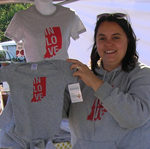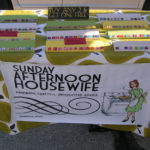From Craft Consumer to Craft Vendor
As a craft dabbler, I love summer craft shows. I enjoy not only buying crafts (although that’s always fun), but also getting craft ideas. And, briefly, after every craft fair, I wonder, “Could I profit from my own adventures in crafting?”
Apparently I’m not the only one asking this question! Many craft-show attendees voice these thoughts, says Martha Latta, who has participated in over 73 craft shows in the past three years. “Sometimes, they’ll just walk up to you and say, ‘I want to set up my booth here. Where do I sign up?'”
And, although supportive of these newbies, she also finds the question frustrating. “It’s just not that simple,” she explains.
Martha has been crafting professionally under the moniker Sunday Afternoon Housewife for four years. Her clothing, jewelry, and magnets are sold in craft fairs, online, and in 19 different U.S. shops—from Massachusetts to Texas. A part-time teacher at Ivy Tech Community College in Indianapolis, Indiana, she’s no stranger to helping people learn new things. So, here are Martha’s well-practiced tips to go from craft consumer to craft vendor.
Martha’s Craft Vending Tips
Know Your Shows.
There’s a big difference between juried and non-juried shows. Juried shows are generally larger, nationally renowned, and will not accept walk-ins. “Usually, you have to fill out an application three to five months in advance,” says Martha.
To find application dates for juried shows:
- Check their website at least five months before the show.
- Sign up for their e-newsletter.
- Follow them on Facebook. (Martha advises that this is the best way.)
The non-juried craft shows are generally first-come, first-serve. “Some you could email a week before [the show] and still get in.”
For beginners, Martha suggests attending a few non-juried shows. But do your research, she warns. “You have to ask, what do you want to surround yourself with? At non-juried shows there are a lot of hobbyists. And Tupperware and Mary Kay. And wholesale stuff; it might be handmade, but probably in China. You can’t compete with wholesale prices.”
Before jumping into any old craft show, it might be a good idea to ask around—unless you want to compete with thousands of 99-cent lilac sachets or machine-made plastic tubs.
Get Organized.
Martha’s an expert in scheduling. In 2004, Sunday Afternoon Housewife began as a self-published zine. It was dedicated to band interviews and local show times. So, even then, Martha was honing her planning and scheduling skills. Now she keeps all the dates for her upcoming craft shows in a calendar.
What to include on your calendar:
- Application deadlines
- Acceptance dates for shows
- Show set-up and tear-down times
- Dates of shows in which you’ll be participating
Start Crafting.
- Find one craft you can do quickly.
- Master it.
- Make as many as you can.
When asked about her first show, Martha just laughs. “The weather was terrible,” she says. “We weren’t prepared. We had an awkward mix of crafts, and we ran out. That’s when I realized I needed to find one craft I wanted to do, and stick with it. I don’t make money off of knit and crochet—I’m too slow. One girl I know can knit a hat in an hour! That’s not me.”
Martha is author of the e-book, The Blogging Adventure: Tips & Prompts for a Crafter by a Crafter, and offers an e-course titled “30 Day Blogging for Crafters.” To purchase Martha’s e-course, e-book, jewelry, magnets, and clothes, or see a checklist of what items you should bring to your first craft show, visit SundayAfternoonHousewife.com.


